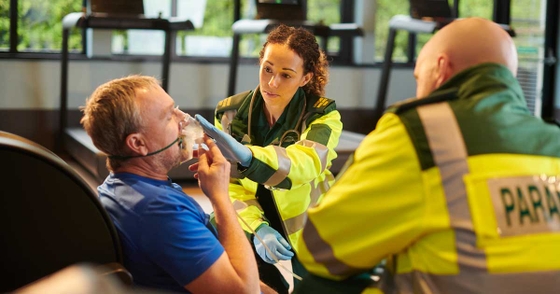
Superheroes saving lives: unmasking five Heart Foundation researchers
Blog: 15 June 2022
When you picture a superhero, what springs to mind? Is it their unique superpowers? Is it their speed or strength? Maybe even their, er, spandex onesie? Whatever it is, we want to challenge you to rethink your idea of a typical superhero. In this blog, we unmask five Heart Foundation researchers doing out-of-this-world research to save lives from heart disease.
Associate Professor Hang Ta, alias Ironwoman
A/Prof Hang Ta, from Griffith University, is exploring how metals like iron and gold could help diagnose people with a build-up of fatty material (plaque) in their coronary arteries. Plaque can rupture and form a blood clot, which can block the flow of oxygen and blood to the heart. When this happens, it can cause a life-threatening heart attack. A/Prof Ta’s research is looking at how these metals, also known as ‘nanomedicines’, can be used in a unique and exciting way to identify people most at risk of a heart attack or stroke. “My research focuses on tiny nanomedicines, which will be coupled with MRI technology to detect and treat heart conditions such as blood clots and fatty plaque build-up in arteries," explains A/Prof Ta. "Knowing whether a blood clot is acute or chronic or whether plaque is stable or vulnerable is very important for doctors when deciding on a treatment protocol." A/Prof Ta is also exploring how these metals can help target ultrasound and laser treatments to the blocked parts of an artery, which down the track may mean people can avoid more invasive treatments.
Dr Yashutosh Joshi, alias Spiderman
You’re either one or the other. Are you the designated spider catcher in your household, or the one who runs screaming from the room? Either way, next time take a moment to reflect on how spiders are helping people living with heart failure. Yes, you read that correctly, in some cases spiders are our friends, not our foes…
Dr Yashutosh Joshi, from the University of New South Wales, is exploring how a molecule found in spider venom, Hi1a, can help protect cells from dying in hearts destined for transplantation.
“In certain pathways for organ donation when the heart is donated after death, it almost becomes a race against the clock for us to preserve the heart. The time taken to do this can have an impact on the function of the heart once it is transplanted,” says Dr Joshi.
For many people with end-stage heart failure, a heart transplant is the only available treatment option. Each donor heart is a precious gift, and it’s important we can keep it in as good a condition as possible for transplant. By protecting the heart cells, Hi1a can buy more time for the heart to reach the person receiving it.
The potential of this research is what sets Dr Joshi’s spidie senses tingling.
“We are now in an exciting stage of research where we are studying the effects of Hi1a in a large animal model, and we hope that it can one day be used in humans. The upshot of this would be more heart transplants and better functioning heart transplants, which would potentially help ease heart transplant wait lists,” explains Dr Joshi.
Dr Cheryl Carcel, alias Wonder Woman
Wonder Woman is known for her endurance, strategic thinking, intelligence and healing powers. You could argue that the same skill set is needed when thinking about how to close the gender gap between women and men when it comes to cardiovascular disease.
Dr Cheryl Carcel, from The George Institute for Global Health and University of New South Wales, is doing research to understand why differences in cardiovascular disease outcomes between women and men exist. For example, we know that women have poorer survival than men following a heart attack, and are less likely to receive best practice treatment. We also know that women who have had a stroke are more likely to experience disability and poorer quality of life.
The reasons for these differences are many and complex, and Dr Carcel hopes to untangle this problem one thread at a time.
“It will be crucial to identify where these disparities lie so we can create sex-specific strategies to address them,” explains Dr Carcel.
“Because of my Heart Foundation Postdoctoral Fellowship, I will be able to examine real-world Australian data to answer this important question.”
Associate Professor Nicholas Gilson, alias The Flash
Did you know that truck driving is one of the most important jobs in Australia? ‘Truckies’ (as they are affectionately known) do an incredible job, day in day out, under challenging conditions. We know the pandemic put enormous pressure on our truckies, and we have them to thank for supplying us with vital food, medicines and other essentials (like toilet paper).
However, the long hours sitting in the driver’s seat means truckies are at higher risk of heart conditions and other chronic diseases. A 2022 study of Australian truck drivers found that over one in four had high blood pressure and around one in seven had high cholesterol; both major risk factors for heart disease. And over three quarters of the truckies surveyed were overweight or obese.
While truck drivers keep Australia moving, who keeps our much-needed truckies moving?
Meet A/Prof Nicholas Gilson, from the University of Queensland, who is looking at a unique physical activity intervention to improve the heart health of truck drivers.
“‘Without trucks Australia stops’ is a logo often seen on vehicles across the country and highlights the crucial role road transport plays in the nation’s prosperity,” says A/Prof Gilson.
“But working in this industry comes at a cost. Truck drivers are highly susceptible to cardiovascular disease, type 2 diabetes, and obesity. Urgent action is required to improve the health and wellbeing of truck drivers.”
Channelling the Flash (known for his ability to move at exceptional speeds), A/Prof Gilson’s research is looking at an intervention involving short bursts of high intensity exercise, aptly named ‘Truck-Fit’. Truck-Fit will be delivered in truck depots by an exercise physiologist.
“High-intensity interval training (HIIT) is an ideal form of physical activity for time-poor truck drivers. Our research is finding that as little as four minutes of HIIT, three times a week over 12 weeks significantly improves fitness, reduces muscular pain, and benefits work performance in drivers,” explains A/Prof Gilson.
“We are planning to use the study findings to develop a fit-for-purpose physical activity resource that Australian truck drivers can use anytime, anywhere.”
Dr Lauren Blekkenhorst, alias Green Lantern
What is it about green stuff that just seems to turn kids off? Where do they get their superhuman x-ray vision to detect even the most well-camouflaged green veg in their spaghetti bolognese?
It’s no accident the Green Lantern’s unique power is the ability to conjure any solid green object out of the air; the colour green is a symbol of strength, growth and renewal. Dr Lauren Blekkenhorst, from Edith Cowan University, is also a strong advocate of the green stuff.
Her research has found that leafy green vegetables offer maximum heart health benefits, along with ‘allium’ vegetables (the onion and garlic family) and ‘cruciferous’ vegetables (think broccoli, cabbage, kale).
“We’ve found that people who eat higher amounts of these vegetables have a lower risk of having a heart attack or stroke. These vegetables contain specific ‘bioactive compounds’ that we think are particularly beneficial for our heart and blood vessels,” explains Dr Blekkenhorst.
“Bioactive compounds are a type of chemical found in small amounts in plants and certain foods and have actions in the body that may promote good health.”
You don’t have to just stick to green veggies. At the Heart Foundation, we encourage people to ‘eat the rainbow’ as part of a heart-healthy eating pattern. This means eating a range of different coloured fruits and veggies each day.
Goes to show that not all superheroes wear capes! We believe that all Heart Foundation researchers are superheroes as they find ways to improve the lives of people with heart disease, and to prevent heart disease in the first place. You can learn more about our amazing researchers and their projects here in our research directory.
Every day, we are funding research to save more lives and keep more families together. Donate now.
You might also be interested in...

Do you know these five heart disease risk factors? Many people don’t
If you’ve been reading our blog for a while, you will have a fair idea of some of the common risk factors for heart disease. We’re talking about high blood pressure, high cholesterol, diabetes, and lifestyle risk factors like smoking or not being physically active enough.

Heart attack vs cardiac arrest – know the difference
Learn the difference between heart attack and cardiac arrest, their symptoms, survival rates, and prevention tips to help you respond in an emergency.

Seven surprising symptoms of heart disease
You’re probably familiar with some of the more ‘classic’ symptoms of heart disease. Chest pain (angina) which might feel like an uncomfortable pressure or heaviness. Palpitations or sensation of a racing heart. Feeling short of breath or having difficulty breathing.
Last updated29 July 2024